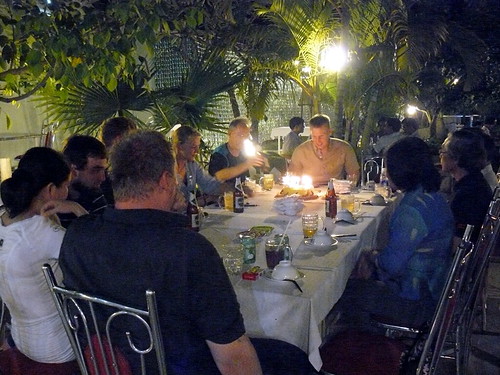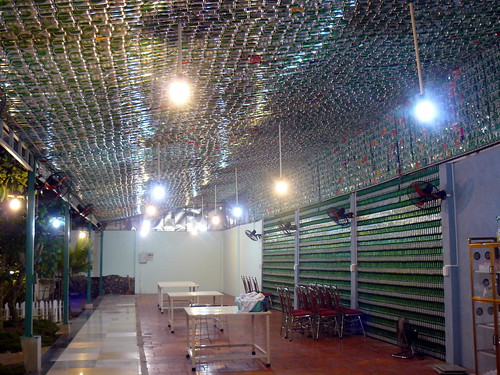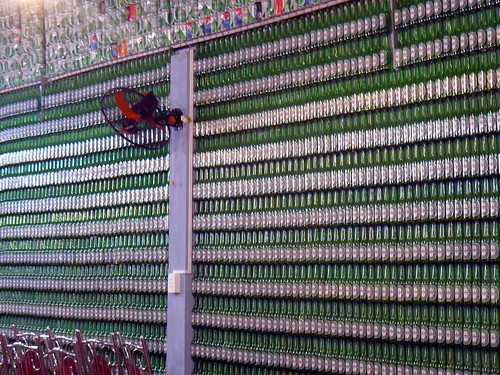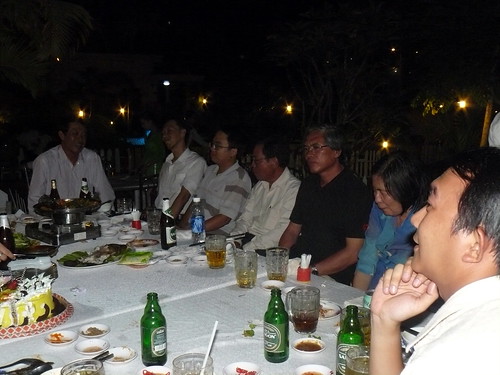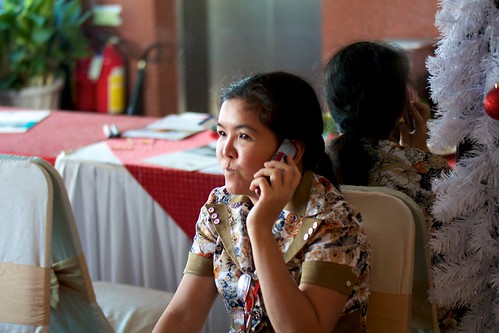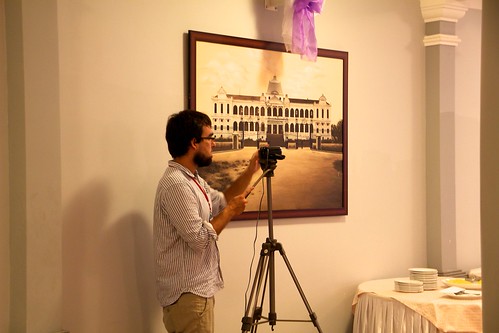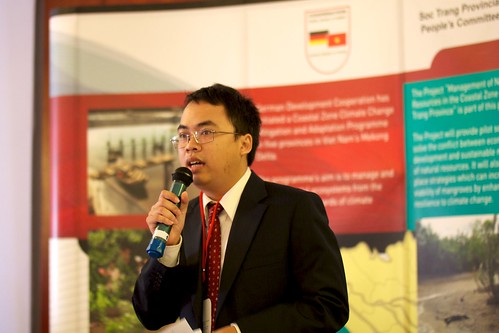The expert panel was facilitated by Mr. Thorsten Albers, from University of Hamburg, Institute of river and coastal engineering. It was more a close discussion where questions were posed to the expert panel for further information on the previous presentations.
Question to everyone of the expert panel: What is, in your opinion, the most suitable means to institutionalize ICAM in the Mekong Delta – Is it an ICAM institution? Or is it an ICAM advisory board (like Bianca has mentioned in her presentation)?
Dr. Klaus Schmitt: The key elements is we need some institution which implement adaptive management, which learn from the experiences, and which is bound to not always succeed 100%, which have the ability to try new thing and learn because we are dealing with changing environment, not only in terms of natural changes which occur in the Mekong Delta through accretion and erosion, but also in changing environment in terms of climate change.
Prof. Tim Smith: Fundamental principles for ICAM can be embedded in any institution and structure. One of the things that I like to add above these is an extract of an Australian newspaper which was published last Monday on Greater Mekong. The headline is about an important issue, which is “Poised for Growth”. That is very critical to understand when we thinking about institution for ICAM. We have to understand the broader context in which the institution is going to be operated. So, a part of co-management concern is sustainable livelihoods and climate change impacts. Huge changes the Mekong in particularly are going through in the next three decades. It is very important to be mindful of that broader context in which the institution is going to be operated. Actually, more critical is that the operation, activities are mainstreamed according to different agendas.
Dr. Stefan Groenewold: I only can agree. I think the idea to create new institution would be a bad idea. Because it takes a long time before any institution hs become effective and can really work. There are a lot of institutions, with capacity building already. We just have to bring them together and think about advisory board for example or create a platform where the knowledge can come together. It is a better and shorter way.
Dr. Andrea Barcelona: I would be speaking from the experiences in the Philippines, which is a province, instead of the project like in Soc Trang. In Negro Occidental province, we have a formal institution, the Coastal Fishery Resource Management – Technical working group. Then there are assisted members from the provincial officers of different national agencies. DONRE and DARD take care of the areas of reforestation, mangrove protection and management. We also have alliances which are groups of municipalities, coming together to form one management body to address certain issues. In the case of Negro Occidental, four alliances have been grouped together to address issues critical to the coasts and coastal resources. We have three offices from the provinces, representing the provinces. So that is the agriculturalist, the cultural, land use plan, water use, zoning plan… provincial environmental management offices. And then we have provincial offices of those national government agencies, the four alliances. GIZ is only an external partner, we are not the member of the technical working group but we are there to assist that body. For 8 years of implementation, it is quite a success. So I would recommend this for local counterpart with that kind of institution.
Dr. Nguyen Huong Thuy Phan: We can just include the ICAM principles into the existing institution. That means there would be a legal framework that requires different institutions, considering multiple objectives, multiple issues. If we establish a technical advisory board, or a management board, the composition of the board has to include all the aspects related to the coastal region. If we consider the spatial scope of the issues, then it should be not only the coastal itself but it should also include concerned and players of the hinterland and offshore. It is just institutionalization of principles into the existing ones.
Dr. Nguyen Chu Hoi: Institutionalization to successfully implement ICAM and to stabilize long term ICAM even after the donors leave is the top priority of governmental strategy for ICAM. The governmental decree No.25/2009 on integrated management of environment and resources has made ICAM as a prerequisite for the local authorities. Currently, there are four circulars in preparation, which give guidelines and instructions for implementing this decree No.25. Among that, there is a circular that instruct specifically on ICAM as a new way of management in Vietnam, expansion into integrate sea and islands in the future.
Secondly, ICAM will be institutionalized into a chapter in Law of Sea’s Resources and Environment. UNDP also would like to continue supporting in second phase in the preparation of this Law, including the implementation. This is a very big will of governance after clearly recognized of ICAM. It will involve the participation of many sectors to harmoniously solve the conflict benefits of different sectors to achieve the three objectives: multi-sectors/disciplinary, multi-objectives, and multi-benefits among different stakeholders.
Thirdly, about policies, there will be a consensus throughout nation that will make guidelines for building a plan for ICAM as well as establishing a criterion set for ICAM implementation assessment. These are also tools for management. There is already international criterion set but how to apply for Vietnam.
It is expected that in December if early enough, MONRE with consultancy from experts will decide whether there is a need for Deputy Prime Minister in national institution or at least, Minister of MONRE or Deputy Minister of MONRE will be the national director of ICM Steering Committee. There will be a supporting office, and a technical group assisting this office. In order to take the advantages of the technical expertise, and international donors, there will be a technical networking (a network of ICAM technical experts) that helping Vietnam in specific issues of specific areas or at national level.
And about the Mekong Delta, there will be a regional framework. And this framework has to to serve for stable growth, social welfare, environment and resources issues.
In Mekong Delta, currently we have the national director board of Mekong Delta. They have all the authority. We have to make them understand ICAM and institutionalize ICAM office into their body. The current mechanism is that every year or every other year there will be a forum on Development of Mekong Delta. In this forum, innovative way of management and environmental sector are also have specific sections.
We have to look at the Mekong Delta as a complex system. If we only conduct small and individual projects, we can just raise awareness and through that building capacity for local so that in the future local can do ICAM themselves.
On the other hand, to solve a problem of integrated management in a way that lacks of ICAM framework for the whole Mekong Delta region, after the project have completed, things will stay the same as before. For example some community development project sponsored by foreign aids, after donors leave, things remain as before, because we lack of institution/framework and lack of financial source to continue.
For Mekong Delta, we should think of macro solutions. We should look at the impact of upstream into the deltas, climate change, sea level rise, and in the delta development’s activities as well as climate change. They are multi-dimensional interaction that we have to consider in order to give macro consultancy.
For recent hard solutions such as dyke, dam, blocking rivers, building dams…, just only look at macro level of the processes and respecting nature in Mekong Delta, the government can just oppose these, no need to spend billions (VND) for assessment and research. We often go much into details and forget about the bigger picture (at macro level) of the whole system. Therefore we often get different consultancies which sometimes be used for negative political reasons and making confusing. Sometimes, we just need only public debate to get into decision and does not need some billions costly researches.
Mekong Delta is facing these challenges. And in the coming future, there will be more challenges if we are not able to see its basic rules and interaction, relationships in which human is an important factor.
For Dr. Klaus Schmitt: We have heard a lot about ICAM but nothing about the people who will plan and implement ICAM. Therefore, my question to Dr. Schmitt is what are the most important qualities or attributes of the people who plan and implement ICAM?
It is people who make decisions. The decision-makers in ICAM must adapt to changes in the coastal zones. That is a very important attribute. But not only adapting to changes, they must also make decisions based on clear understanding of a given situation. (A good decision-maker must consider what is going on and not assuming the situation as last time). A good decision-maker must analyze the situation, understand what is going on and then make a site-specific decision.
In certain point, it is communication. A decision-maker needs to communicate. Communication involves many people. Coastal zone management involves many people many interests. In coastal area management, people living in the coasts have their own interests, the business have their interest, nature has its interest, and a good manager, a good decision-maker, must understand all these and communicate with everybody and doesn’t make decision just sitting behind the desk and ignore everybody else.
In short, making decision in a changing environment, making site-specific decision based on a sound understanding of what’s going on, and communicating the decision to all the stakeholders, taking consideration of their interests, these make a good ICAM decision-maker.
For Prof. Tim Smith: When considering the development of a new institution for coastal management it maybe prudent to be aware of some of the mistakes that the others have made throughout the world. Why have some of the attempts of ICAM failed?
The challenge with ICAM is that there are so many interests. So it is very difficult to communicate with a single message, it must be multiple messages. It is very important to be aware of different motivations and preferences of the stakeholders involved. (For instance, some people may be motivated by conservation, other by safety issues, livelihood…). It is not necessarily a problem because, ICAM, by its nature should be integrated all of the concerned. Communication tools are also very important. Some people like digital media, other people like physical paper, other people like sitting there and talking. Such things can be challenges with communication in ICAM.
In relation to the question, it is very important to be mindful of the state. What is the state, what are the external influences on ICAM institution. So does it have a mandate, does it have resources? Where is the situation in a hierarchy? Another important factor to consider is how the institution related to the stakeholders, through communication, and more by engagement.
Most important thing is the internal process within the institution. It would be wrong to create another institution. One key characteristic is to make sure it is a sustaining institution; adaptive, learning institution. That is a fundamental point.
For Dr. Stefan Groenewold: How can we strengthen already existing national and regional institutions and networks to develop and integrate practical knowledge on ICAM? (How can we optimize the process of ICAM?) What is the role of universities and international knowledge institutions (experts from abroad) in promoting ICAM? (Is that a way to optimize ICAM?)
It is definitely a way. The role of science can be fundamental. Coastal zone management starts with a good understanding of what happening now. It should be done on both ways, with participatory coastal resource assessment but it should be strongly supported by science.
The next step where science also would be very important is planning. For a good planning, you need modeling predicting scenarios. What happen to the area when sea level rise, what happen if there is no sediment load in the Mekong river anymore, things like these… possible consequences of policy makers as well as local people have…
Thirdly, scientists help with evaluating what is going on. It can evaluate the progress of the ICAM. Somehow you need a reference to see if our activities are really during ICAM accordant to the principles. It should be outside academic institution but not some office stakeholder itself (to avoid bias in evaluation process).
Finally, it is very important to have this scientific capacity building in the region. They are a lot of institutions like this, of course with external network, scientific institutions can help a lot.
For Dr. Andrea Barcelona: Who are the key players in GIZ assisted ICAM sites in the Philippines?
The beneficiaries are first and foremost, the fisherfolks, not the government, not the academic, everything is done for the betterment livelihood of the fisherfolks. Then the implementers who are service providers for the fisherfolks (staff of the local government unit). Those people with the mandates by law to carry out services for coastal resource management, land use planning or whatever… And then the higher level of governmental agencies, see through if that everything is according to national plan, and at provincial level. GIZ would come only to provide technical assistance.
For Dr. Nguyen Huong Thuy Phan: MRC has to deal with many different institutions, and it is always a challenge to coordinate different countries. So, how does it work, it is easy or where is the difficulty in the cross-border approach?
Talking about the working across border or transboundary issues, the position of MRC will be different to other institutions. We are intergovernmental organization, established by the member countries. So for us, boundary issues now are issues appear when we have the common environment (there is an international river). Basically when you have to work with multiple objectives, multiple benefits like ICAM or some other transboundary issues, of course it is not that easy. But anyway you have platform for negotiation, platform for building mutual understanding and such and you have to work with it. So, the answer from the MRC position will be difficult because for every issue, we have to come up with agreement from all the member countries.
For Dr. Klaus Schmitt: Wadden Sea is a World Heritage Site. And the mudflat of Soc Trang is not very different from that one. Is it possible to make that of Soc Trang a Marine Protected Area one day?
Protected area can support the development and the conservation of the region. The mudflat is formed in the Mekong river are unique ecosystems. For some aspects such as the dynamic nature, dynamic process of accretion and erosion, it would be worth considering this area for special status to recognize its importance, which then might attract tourism or other means of finance that can help local people with their livelihood, stopping some unsustainable fishing, providing them alternative livelihood. It is something should be considered by relevant authorities. I hope we have enough people here who hear this message.
For Dr. Nguyen Chu Hoi: What is a realistic time frame for an ICAM strategy? 2020, 2050, 2100?
In my presentation I talked about the ICAM strategy for 2020. The road map has been divided into 2 phases according to the 2 socio-economic development phases (2011-2015 and 2016-2020). These are the time frame for implementation of the ICAM strategy. When this strategy is approved by Prime Minister, we will have to make a detail action plan. It would be ICAM plan, not only ICAM strategy any more. (The order of priorities may be modified with different provinces, according to their own strengths and specific environmental characteristics…). Currently, we already have the ICAM implementation plan for up to 2015.
About the international aids, there are ongoing projects, firstly in Quang Ninh – Hai Phong, sponsored by NOOA (US). Then 7 provinces supported by PEMSEA, including Nam Dinh, Soc Trang… Then 14 central provinces have been continued receiving support from the government (500 billion VND) and PEMSEA. PEMSEA continues to consolidate their success in Da Nang, Quang Nam and Thua Thien Hue, and continue to consolidate another pilot site which is Khanh Hoa – Nha Trang. In the South, there are Ba Ria Vung Tau, Soc Trang and Kien Giang. Thus, it would be good if GIZ can cooperate with PEMSEA and MONRE and MARD to help Soc Trang making an ICAM model there.
For Prof. Tim Smith: You mentioned recent storm surges, tsunami, earthquakes. Is it possible to defend some coastal areas or maybe it is necessary to retreat, to evacuate…?
Certainly, it would be necessary to try it off some retreat if they cost too much money to protect everything and in fact it would be a short term solution anyway. The important thing to consider is to look at the underline values that people have for particular land use activity. One of the issues for climate change adaptation is that we don’t need them as the underline values. We just simply jump to adaptation strategy to protect what it is already there. What the core underline values are… who has the capacity to retreat, and to maintain what…what need to be protected… that is a complex issue.
For Dr. Stefan Groenewold: Sustainable spatial planning will become very important in the future, especially in terms of climate change and sea level rise? (Why has spatial planning a key role in the ICAM process?)
Both of the technical terms have the possibility to assess what we are doing and to assess the state of environment, using remote sensing. This together with spatial planning, adaptation planning tools make single compartment of the limited space. Integrated impact assessment, with spatial planning can help visualize this and develop scenarios for the future. Spatial planning can be an essential tool for the entire process, not only during planning phase but also for later assessment.
For Dr. Andrea Barcelona: If you have a wish, if you would say well, I want to have a tool which help me to come from the strategy to the concrete measures, what would it be?
In my province, what we are practicing now, for the past maybe 7 years or 5 years…the GIZ practices in Negros Occidental was very limited to nearly just the coast. But now we have national law that mandates all local government units to include in their comprehensive land use plan and this cover a span of 5 years. Just recently, one government agency who oversees all governmental units has told them to incorporate all plans (disaster management plan, forest land use plan, coastal resource management plan, plan for gender, anti-corruption plan…). Now we are really making one plan. We are integrating all these plans into a comprehensive land use plan. The environmental and rural development program has made it a priority and it is a fabulous tool. If you plan for the coastal area, you have to bear in mind that there are forest land use plans that will be affecting your area in 2 or 3 years. So this kind of integrated approach that really helps in planning even to the fisherfolks in community level.
For Dr. Klaus Schmitt: Is there a concrete action which you would propose as a step towards ICAM in the Mekong Delta?
I could think about one concrete step which could be a contribution to a more sustainable ICAM. Mekong Delta is an extremely dynamic delta, and it is changing not only in unique direction but multi-direction and the decision-makers must understand these changes in order to make informed decisions. So, for ICAM, decision-makers need to make informed decisions about planning, they would benefit from a decision-support tool makes prediction about the development of the coastline. This is an idea which I have been proposing to number of people, and we will be discussing with the relevant institutions in Vietnam and the provinces. We will be discussing the possibility of actually carry out a big study which will result in a computer-based decision-support tool, which can be used to predict future changes in the coastline as one input in informing ICAM decision-making. To do something like this, we need to communicate, we need to involve stakeholders. I think about a workshop early next year, where provinces from Mekong Delta and relevant institutes come together and discuss the possibility of jointly developing such a tool.
